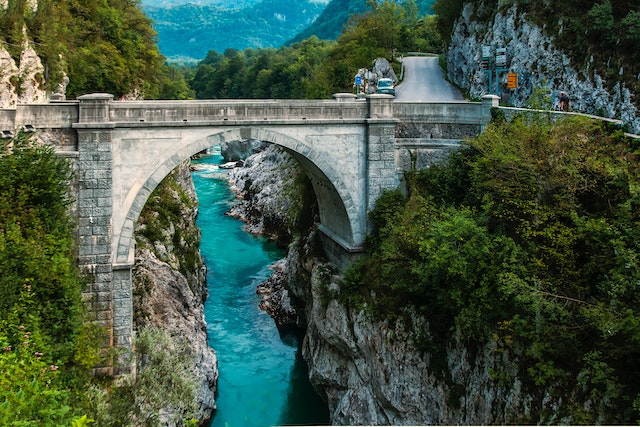
Why are bridges designed to move? Because they expand and contract, because the wind moves them, and because the land on either side of them moves.
When you drive on and off a bridge, you may have noticed there is a slight gap at either end. This gap usually has a metal bracket on it that looks something like the interlocking teeth of an animal. These are called expansion joints and they are there because all things expand and contract under different temperatures. This is known as thermal expansion.
All things are made of atoms that vibrate. The only time atoms are not moving is when they are at absolute zero, which is -273.15℃, and even then, they are still moving on the quantum level. The amount that the atoms move corresponds to how much kinetic energy they have. When something is heated, it gets more kinetic energy, and the atoms start to move more. The more the molecules move, the more space the same volume of material takes up. You can see this by looking at the three main states of matter: solid, liquid, gas. When a material is a solid, the atoms don’t have much kinetic energy and they vibrate without moving out of alignment with all of the other molecules. This state takes up the least space. When they have a little more energy, the atoms can move more and they are able to slide past each other. This is the liquid form and it takes up more space than the solid form. If you supply more heat to the atoms, they start to whizz around, taking up a lot of space, and this is the gas state. So, as objects get more heat energy, they expand.
When engineers design bridges they have to think about thermal expansion. If a bridge is made out of a single solid material, be it brick, metal, or concrete, that material will expand when the weather turns hot and contract when the weather turns cold. The bridge might survive one season with a few cracks, but after repeated expansion and contraction, the bridge will collapse. To prevent this, engineers use expansion joints which give the bridge space to expand. There are three sizes: 45 mm, 130 mm, and over 130 mm. This is because not all materials expand by exactly the same amount. The same consideration has to be taken with things like railway lines as well. There is always a small gap between each rail to allow for expansion. If there is no gap, the rails will expand and buckle.
Bridges also have to be able to move up and down as well, albeit not a lot. Bridges have to be able to survive the vibration and the weight of the traffic that uses them. If they couldn’t move, they would fail more quickly, They are built to be slightly bouncy. Bridges also sit out in all of the elements, so they have to survive high winds. They are designed to move ever so slightly with the wind because this makes them stronger. The same principle is used with skyscrapers. If you are at the top of a very tall skyscraper, it will sway with the wind because this makes it stronger. You can see the same principle in tree branches. If a branch is rigid, it is more likely to snap. Branches that are flexible are far more likely to survive strong winds. However, they are only designed to move a little bit because too much movement can be bad. In 1940, the Tacoma Narrows Bridge shook itself to pieces due to the wind. The bridge was too loose, and the wind made it sway. The swaying of the bridge coupled with the wind and it kept putting more energy back into the bridge, until it fell to pieces. There is an interesting video of the bridge on YouTube.
Bridges also have to be able to move because the land on both sides of the bridge might not move in the same way. All the land we are standing on moves with the Tectonic plates, but things like earthquakes, rainfall, and subsidence can make the ground move unpredictably. If a bridge is made out of a solid structure and both ends move in a different way, it will crumble. Giving the bridge the ability to move a little will help it to survive any of these things. And this is what I learned today.
Photo by Janez Podnar: https://www.pexels.com/photo/concrete-bridge-over-clear-blue-river-beside-mountain-1424239/
Sources
https://www.popularmechanics.com/science/a18757126/how-and-why-bridges-are-made-to-move/
https://www.physlink.com/education/askexperts/ae40.cfm
https://www.solarschools.net/knowledge-bank/energy/types/thermal
https://www.designingbuildings.co.uk/wiki/Thermal_expansion
https://en.wikipedia.org/wiki/Bridge
